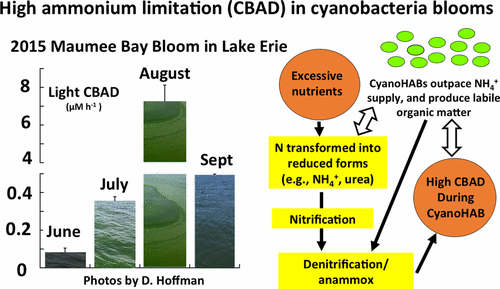当前位置:
X-MOL 学术
›
Environ. Sci. Technol.
›
论文详情
Our official English website, www.x-mol.net, welcomes your
feedback! (Note: you will need to create a separate account there.)
Community Biological Ammonium Demand: A Conceptual Model for Cyanobacteria Blooms in Eutrophic Lakes
Environmental Science & Technology ( IF 10.8 ) Pub Date : 2017-07-07 00:00:00 , DOI: 10.1021/acs.est.6b06296
Wayne S. Gardner 1 , Silvia E. Newell 2 , Mark J. McCarthy 1, 2 , Daniel K. Hoffman 2 , Kaijun Lu 1 , Peter J. Lavrentyev 3 , Ferdi L. Hellweger 4 , Steven W. Wilhelm 5 , Zhanfei Liu 1 , Denise A. Bruesewitz 6 , Hans W. Paerl 7, 8
Environmental Science & Technology ( IF 10.8 ) Pub Date : 2017-07-07 00:00:00 , DOI: 10.1021/acs.est.6b06296
Wayne S. Gardner 1 , Silvia E. Newell 2 , Mark J. McCarthy 1, 2 , Daniel K. Hoffman 2 , Kaijun Lu 1 , Peter J. Lavrentyev 3 , Ferdi L. Hellweger 4 , Steven W. Wilhelm 5 , Zhanfei Liu 1 , Denise A. Bruesewitz 6 , Hans W. Paerl 7, 8
Affiliation

|
Cyanobacterial harmful algal blooms (CyanoHABs) are enhanced by anthropogenic pressures, including excessive nutrient (nitrogen, N, and phosphorus, P) inputs and a warming climate. Severe eutrophication in aquatic systems is often manifested as non-N2-fixing CyanoHABs (e.g., Microcystis spp.), but the biogeochemical relationship between N inputs/dynamics and CyanoHABs needs definition. Community biological ammonium (NH4+) demand (CBAD) relates N dynamics to total microbial productivity and NH4+ deprivation in aquatic systems. A mechanistic conceptual model was constructed by combining nutrient cycling and CBAD observations from a spectrum of lakes to assess N cycling interactions with CyanoHABs. Model predictions were supported with CBAD data from a Microcystis bloom in Maumee Bay, Lake Erie, during summer 2015. Nitrogen compounds are transformed to reduced, more bioavailable forms (e.g., NH4+ and urea) favored by CyanoHABs. During blooms, algal biomass increases faster than internal NH4+ regeneration rates, causing high CBAD values. High turnover rates from cell death and remineralization of labile organic matter consume oxygen and enhance denitrification. These processes drive eutrophic systems to NH4+ limitation or colimitation under warm, shallow conditions and support the need for dual nutrient (N and P) control.
中文翻译:

社区生物铵需求:富营养化湖泊中蓝细菌水华的概念模型
人为压力(包括过多的养分(氮,氮和磷,磷)输入和气候变暖)会增强蓝藻有害藻华(CyanoHAB)。水生系统中的严重富营养化通常表现为非N 2固定的CyanoHAB(例如,微囊藻属),但是需要确定N输入/动力学与CyanoHAB之间的生物地球化学关系。社区生物铵(NH 4 +)需求(CBAD)将N动态与总微生物生产力和NH 4 +联系起来水生系统的剥夺。通过将营养循环和来自一系列湖泊的CBAD观测相结合,构建了机械概念模型,以评估与CyanoHAB的N循环相互作用。来自2015年夏季伊利湖莫米湾微囊藻开花的CBAD数据为模型预测提供了支持。氮化合物转化为CyanoHAB偏爱的还原型,生物利用率更高的形式(例如NH 4 +和尿素)。在开花期间,藻类生物量的增加速度快于内部NH 4 +再生速度,从而导致高CBAD值。细胞死亡和不稳定的有机物再矿化产生的高周转率会消耗氧气并增强反硝化作用。这些过程将富营养化系统驱动到NH 4+在温暖,浅水条件下的限制或共限制,并支持双重营养素(氮和磷)的控制。
更新日期:2017-07-08
中文翻译:

社区生物铵需求:富营养化湖泊中蓝细菌水华的概念模型
人为压力(包括过多的养分(氮,氮和磷,磷)输入和气候变暖)会增强蓝藻有害藻华(CyanoHAB)。水生系统中的严重富营养化通常表现为非N 2固定的CyanoHAB(例如,微囊藻属),但是需要确定N输入/动力学与CyanoHAB之间的生物地球化学关系。社区生物铵(NH 4 +)需求(CBAD)将N动态与总微生物生产力和NH 4 +联系起来水生系统的剥夺。通过将营养循环和来自一系列湖泊的CBAD观测相结合,构建了机械概念模型,以评估与CyanoHAB的N循环相互作用。来自2015年夏季伊利湖莫米湾微囊藻开花的CBAD数据为模型预测提供了支持。氮化合物转化为CyanoHAB偏爱的还原型,生物利用率更高的形式(例如NH 4 +和尿素)。在开花期间,藻类生物量的增加速度快于内部NH 4 +再生速度,从而导致高CBAD值。细胞死亡和不稳定的有机物再矿化产生的高周转率会消耗氧气并增强反硝化作用。这些过程将富营养化系统驱动到NH 4+在温暖,浅水条件下的限制或共限制,并支持双重营养素(氮和磷)的控制。































 京公网安备 11010802027423号
京公网安备 11010802027423号